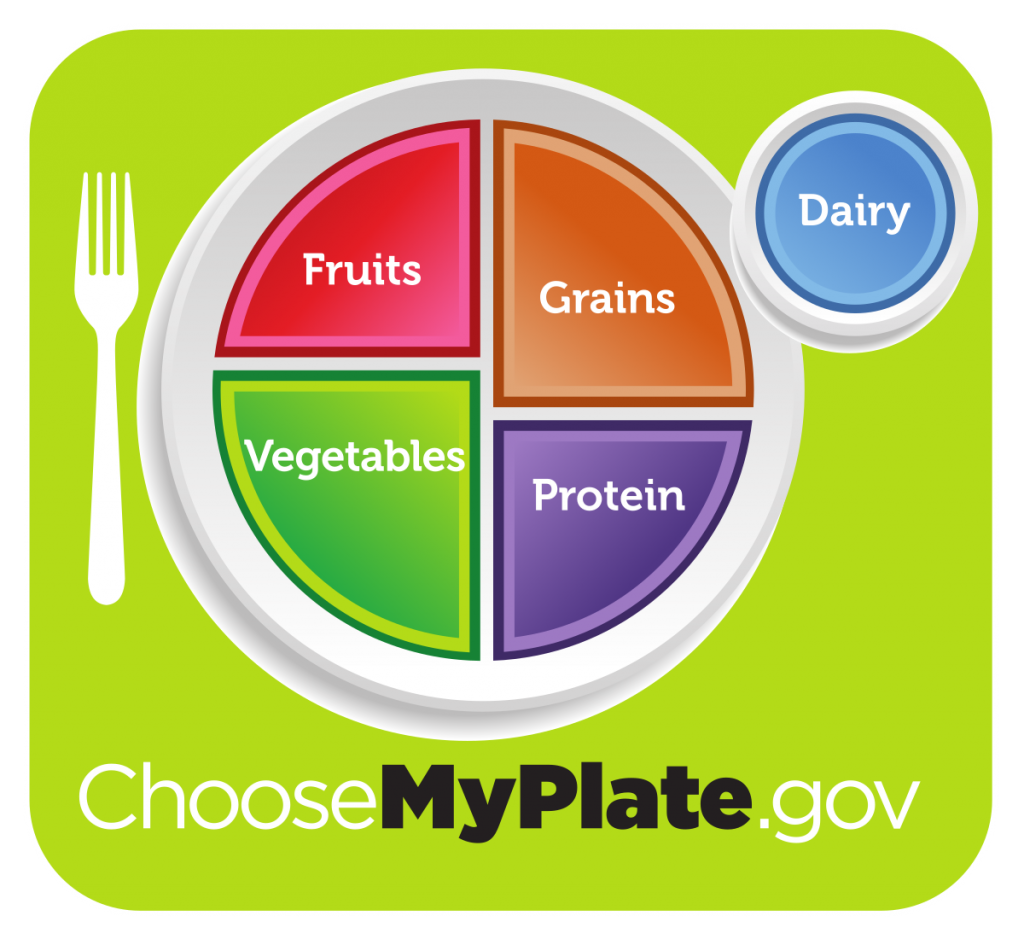Choose My Plate – United States Department of Agriculture

First Lady, Agriculture Secretary Launch MyPlate Icon as a New Reminder to Help Consumers to Make Healthier Food Choices
WASHINGTON, June 2, 2011 – First Lady Michelle Obama and Agriculture Secretary Tom Vilsack today unveiled the federal government’s new food icon, MyPlate, to serve as a reminder to help consumers make healthier food choices. MyPlate is a new generation icon with the intent to prompt consumers to think about building a healthy plate at meal times and to seek more information to help them do that by going to www.ChooseMyPlate.gov. The new MyPlate icon emphasizes the fruit, vegetable, grains, protein and dairy food groups.
“This is a quick, simple reminder for all of us to be more mindful of the foods that we’re eating and as a mom, I can already tell how much this is going to help parents across the country,” said First Lady Michelle Obama. “When mom or dad comes home from a long day of work, we’re already asked to be a chef, a referee, a cleaning crew. So it’s tough to be a nutritionist, too. But we do have time to take a look at our kids’ plates. As long as they’re half full of fruits and vegetables, and paired with lean proteins, whole grains and low-fat dairy, we’re golden. That’s how easy it is.”
“With so many food options available to consumers, it is often difficult to determine the best foods to put on our plates when building a healthy meal,” said Secretary Vilsack. “MyPlate is an uncomplicated symbol to help remind people to think about their food choices in order to lead healthier lifestyles. This effort is about more than just giving information, it is a matter of making people understand there are options and practical ways to apply them to their daily lives.”
Originally identified in the Child Obesity Task Force report which noted that simple, actionable advice for consumers is needed, MyPlate will replace the MyPyramid image as the government’s primary food group symbol as an easy-to-understand visual cue to help consumers adopt healthy eating habits consistent with the 2010 Dietary Guidelines for Americans. MyPyramid will remain available to interested health professionals and nutrition educators in a special section of the new website.
ChooseMyPlate.gov provides practical information to individuals, health professionals, nutrition educators, and the food industry to help consumers build healthier diets with resources and tools for dietary assessment, nutrition education, and other user-friendly nutrition information. As Americans are experiencing epidemic rates of overweight and obesity, the online resources and tools can empower people to make healthier food choices for themselves, their families, and their children. Later this year, USDA will unveil an exciting “go-to” online tool that consumers can use to personalize and manage their dietary and physical activity choices.Over the next several years, USDA will work with First Lady Michelle Obama’s Let’sMove! initiative and public and private partners to promote MyPlate and ChooseMyPlate.gov as well as the supporting nutrition messages and “how-to” resources.
The 2010 Dietary Guidelines for Americans, launched in January of this year, form the basis of the federal government’s nutrition education programs, federal nutrition assistance programs, and dietary advice provided by health and nutrition professionals. The Guidelines messages include:
Balance Calories
•Enjoy your food, but eat less. •Avoid oversized portions.
Foods to Increase
• • •
Make half your plate fruits and vegetables. Switch to fat-free or low-fat (1%) milk. Make at least half your grains whole grains
Foods to Reduce
•Compare sodium (salt) in foods like soup, bread, and frozen meals, and choose foods with lower numbers.
•Drink water instead of sugary drinks.
Coupled with these tested, actionable messages will be the “how-tos” for consumer behavior change. A multi-year campaign calendar will focus on one action-prompting message at a time starting with “Make Half Your Plate Fruits and Vegetables.”
“What we have learned over the years is that consumers are bombarded by so many nutrition messages that it makes it difficult to focus on changes that are necessary to improve their diet,” said Secretary Vilsack. “This new campaign calendar will help unify the public and private sectors to coordinate efforts and highlight one desired change for consumers at a time.”
What foods are in the Vegetable Group?
Any vegetable or 100% vegetable juice counts as a member of the Vegetable Group. Vegetables may be raw or cooked; fresh, frozen, canned, or dried/dehydrated; and may be whole, cut-up, or mashed.
Vegetables are organized into 5 subgroups, based on their nutrient content. Some commonly eaten vegetables in each subgroup are:
Dark green vegetables
bok choy
broccoli
collard greens
dark green leafy lettuce
kale
mesclun
mustard greens
romaine lettuce
spinach
turnip greens
watercress
Red & orange vegetables
acorn squash
butternut squash
carrots
hubbard squash
pumpkin
red peppers
sweet potatoes
tomatoes
tomato juice
Beans and peas*
black beans
black-eyed peas (mature, dry)
garbanzo beans (chickpeas)
kidney beans
lentils
navy beans
pinto beans
soy beans
split peas
white beans
Starchy vegetables
cassava
corn
fresh cowpeas, field peas, or black-eyed peas (not dry)
green bananas
green peas
green lima beans
plantains
potatoes
taro
water chestnuts
Other vegetables
artichokes
asparagus
avocado
bean sprouts
beets
Brussels sprouts
cabbage
cauliflower
celery
cucumbers
eggplant
green beans
green peppers
iceberg (head) lettuce
mushrooms
okra
onions
parsnips
turnips
wax beans
zucchini
* For more information on Beans and Peas, see Beans and Peas Are Unique Foods.
Key Consumer Message: Make half your plate fruits and vegetables.
Source (www.choosemyplate.gov)
Leave a Reply
You must be logged in to post a comment.